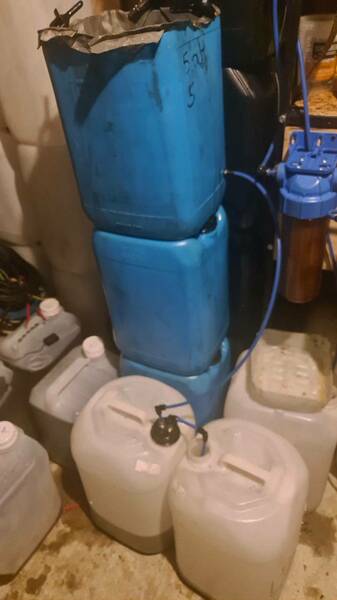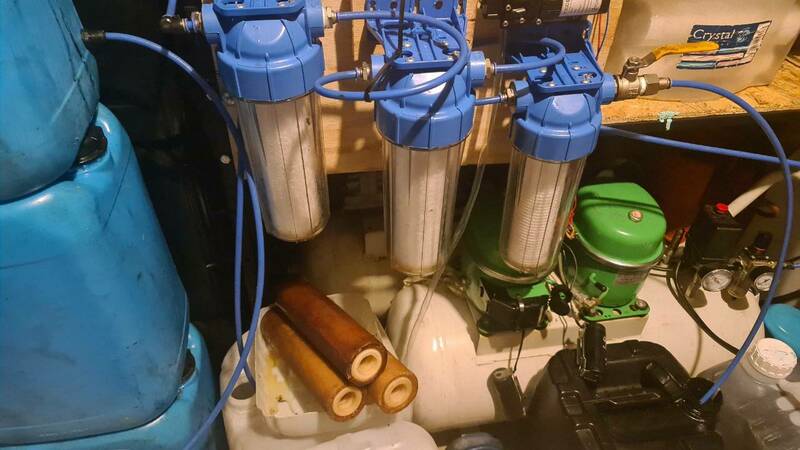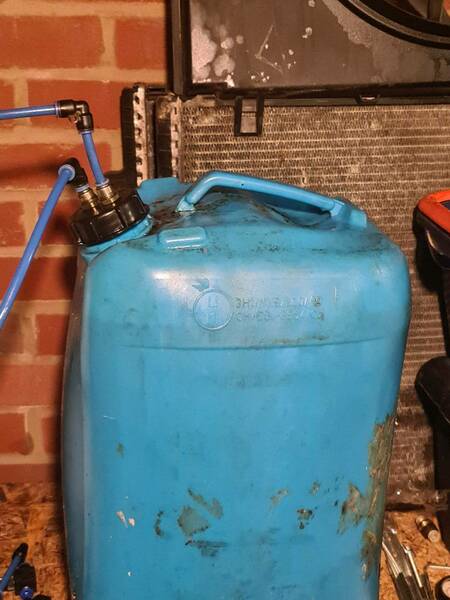-
Posts
7,429 -
Joined
-
Last visited
-
Days Won
8
Content Type
Profiles
Forums
Events
Everything posted by Talbot
-
I suspect the sand may have imparted some acidity to the oil, which will have corroded the life out of vulnerable items. Sand can be up to pH3, which is pretty agressive.
-
What I need to do is just not leave the cubies on the cold concrete floor, as it acts like a massive heat sink. The weather needs to be warm for about a month for it to properly warm up. 3 days just doesn't cut it. If I get them up on palettes or up on racking, the warmer air can blow all around them and they might actually fully re-liquify.
-
Had a bit of an update of the veg system to make it a bit more hands off. Having just been able to get 450 litres of oil, I need to get filtering! The header tank now has connections for inlet (oil or compressed air) on the right. A 95% depth dip tube for emptying through the filters in the centre, and a part-height dip-tube on the left, which goes down to a blowdown tank. That way I can now set a container filling the header tank, and when it gets to the magic 15L of oil ready for a batch, the excess blows down the left tube into a catch tank. When the oil exhausted from the supply tank, again, all the excess air just blows through. It makes more sense in person. Maybe. Same is also now true of the initial 125um filter. A couple of times in the past I have over-done it with the coarse filter tank, and as it's draining (via gravity) through the bottom into a catch tank, I've over-filled the catch tank and spilled oil. Not ideal. So now it's slightly modified. The coarse filter is up higher: And when it drains down into the first catch tank, that then also now has an overflow: The right-hand connection has a short dip-tube into the tank. This means that as the left container fills, air is pushed out of the right-hand pipe. When the level gets to that pipe, an airlock forms in the top of the left tank, pushing the excess oil out into the right-hand tank. When there is no more oil coming down out of the coarse filter, the short link-pipe acts as a small siphon, bringing the level in the left tank back down to the height of the dip tube. I didn't expect this to work nearly as well as it does! Now I can load up the coarse filter with enough to fill the catch tank and a bit more, and every time I come back to it, I have another 25L tank completed. Saves having to nanny the tank to make sure it's full, but doesn't overflow. Also discovered recently that the pressure I can apply to the oil going through the three filter assemblies could do with being raised a bit. At 2psi, the oil barely flows. At 3psi, it starts to move a bit, but the header tank looks like it's going to explode! If I bypass the tank and just apply pressure direct from the compressor, you can push the remaining oil through with MUCH higher pressure. 10psi and it starts flowing at a far higher rate. 15psi and it absolutely hammers through. If I could get a header tank that could tolerate 10psi, I recon I could filter about 5 times quicker. At 15psi it would take minutes to do that 15L of oil, which currently takes several hours. The plastic of these tanks could probably take about 100psi before it fails, it's just that the shape is not at all condusive to pressure, so they end up spherical. Might have to try making a wooden frame for it to sit in, that way it could take more pressure. .... and I'm still waiting for some of the oil to warm up. It's been over 8c for the last few days (and up to 12c during the day) and yet some of the 20L cubies I have to deal with are still at about 3c and badly waxed. Might have to leave them out in the sun soon.
-
Following on from the query about filters... time for a filter change. Given that these filters got rather heavily waxed recently, I thought it was worth a few quid to change them. Old filters in the tub, new ones in the housings. The old ones were quite a bit dirtier than I thought. I did briefly consider keeping the old ones, and used a plug in either end to blow a load of compressed air through them. It did get a lot of shite out of them, and they looked significantly cleaner: However, this is the third time I've done this to these filters, so given how cheap they are, it has to be time for them to get binned. Plus I managed to lose track of which one is which, so buggerit.
-
That sounds every kind of dodgy.
-

Six Cylinders Motoring Notes - Saying goodbye to a fleet member!
Talbot replied to Six-cylinder's topic in AutoShite
It's a slow leak. When the clutch was changed, the slave was put back together (it had spat the piston right out) but it looked ok, so the decision was made to leave it for the time being. I've topped it up a couple of times, hoping that it was just air. Clearly it's not, and it's weeping slightly. I'd lob a new slave on it. The master wasn't really affected, but the slave has been in bits so the bore may be damaged. -
https://www.ebay.co.uk/str/aqfilters or direct from them. They're a standard 10" (now 250mm) filter element, which can be bought in all manner of types and styles from a string-wound debris filter to a ceramic block filter which is so fine it will filter viruses. Almost all water filtration is done with these.
-
Was pretty normal mpg tbh. Speed restricted to 60mph and the ami being small (minimal wind resistance) and light (700kg maybe?) Meant I was getting an easy 35mpg.
-
Well, there was definitely two when I found out that the front tyres on the Ami were at 15psi and 58psi. "Oh shit that's a bit soft, and the tyre is a bit warm." "Oh shit that's about to explode!" Other than very nearly running out of fuel on the last stint (and being very glad I was carrying an additional 50L of veg) it was a fairly uneventful tow. But possibly the longest A-frame I've done in one go. 340 miles in about 8hrs. 60mph limit (rigidly adhered to) and three stops. Also got a very odd look from an AA van bloke at one of the stops who was using a front-axle-lift tow on a car. It was a "how in the whart now?" sort of look.
-
That was if you were caught on Red. They'd assume you've been running 20k miles a year since you bought the vehicle and tax you accordingly. Same was true before the deminimus rule was introduced for veg, but now they basically ignore it. So few people have a car that can run veg now that it's not really an issue anymore.
-
Bumhats. It's a bit cold! Oil in larger containers hasn't waxed as it's a big thermal mass. The little bits in the filters, however.... The irony of needing a diesel heater in the garage to heat up the oil being used instead of diesel fuel.😡 Have just left it to blat another 18L through overnight, so it'll be interesting to see in the morning if the whole thing is a big chunk of wax, or if the liquid from the header tank has melted the waxing in the filters. Certainly hope so, I need a fair bit of veg this weekend.
-
Did you see the video that Richard Kitchen (Up-n-Down on youtube) did when he put it on the Dyno? Frickin' hillarious. It's making about 35hp at the wheels!
-
I love that all of these 0-60 times that are being compared could be measured on a calendar, and that 30s is "fairly quick"
-
This is very interesting/handy to know. May have to hunt that down, as a bit of Kero in veg does make a big difference to cold viscosity and also cold starting capability.
-
2500 litres per annum per person. However, like all good UK legislation, there is no requirement in law to keep any kind of record of how much veg you have "converted" into fuel or indeed used. I also love the fact that this deminimus rule came about because so many people were registering as an alternative fuel provider and paying their 40-ish pence-per-litre of duty on their veg that HMRC were overloaded with paperwork and they decided it was less expensive to just allow individuals to have an annual allowance. 2500l even in something as thirsty as the E300 still gives me about 18k miles on neat and probably nearer 25000 miles with the diesel blend I use, so it's very unlikely that an individual will even come close to that limit.
-
I think having 20% diesel or kerosene (off road only obvs) will prevent this. I'm not sure, but I've never actually achieved mineral-veg gumming.
-
Fixerated.
-
The filters I use do take quite a fair while to filter oil. It comes out lovely and optically clear, but really slowly!
-
I've run some waste engine oil through at the same time as veg, which made absolutely no difference at all. Same with used atf. If I had a source of hydraulic oil, I'd probably try some.
-
Had to say it didn't you! Veg in a direct-injection engine is definitely possible, but as you say the issues are greater and it definitely has higher risk of ring gumming and other issues. The IDI engine is so much better when it comes to veg that I don't think I would bother even trying. It's mainly to do with the throat between the pre-combustion chamber and the cylinder. This glows red-hot in normal service, so having atomised fuel and air going past a surface that is above the auto-ignition temperature of the fuel rather guarantees that you get complete combustion. It's also why IDI engines need glowplugs: the pug takes on the role of the autoignition surface until the throat gets up to temperature. Di engines are just at so much more risk of incomplete combustion and ring gumming. Older engines are better, as they will use a pintle-type injector, which tends to keep itself clean. Modern injectors have no such arrangement and are so very vulnerable to blocking.
-
This is very true. Good quality biodiesel is ok in common rail direct-injection engines, but as soon as you add in DPF systems or NoX reduction with adblue, it all starts to go a bit wrong. Mechanical IDI engines are the holy grail of veg combustion, even if modified into biodiesel.
-
It just about works from a pressure regulator on the compressor. I plan to get a propane regulator in the fullness of time, as 37mbar would be about ideal, and of course a propane reg can go fro. 6bar down to 37mbar quite reliably. I may see if I can get a variable propane one, as that would be perfect. There is air consumption, so a column of water isn't ideal. Plus I want to keep water away from this system! Tbh the air pressure is only to speed things up. It would all work on gravity if I set it up to do so, but I suspect it would be deathly slow.
-
The reason for the header tank being ratchet strapped to the shelf: These containers are not designed for pressure, and if you put even a couple of psi in them, they do this: The strap stops that from happening, keeping the dip tube pointing at the bottom of the tank and not the opposite corner!
-
Once the oil has come from that stainless mesh, it gets to sit in 25L drums to settle, and to let all the air that has been entrained to bubble out. I find a week is more than plenty, and any longer doesn't seem to make any difference. Next comes the multi-stage filter system. Each 25L gets lifted up onto a high-level shelf, and then by using a dip-tube through a lid and a little bit of air pressure in the top of the barrel, 15 L is pushed over into the "header" tank: This requires very little pressure. The gauge I have is only 0-1 bar, but even just bringing it off it's stop is enough: Quite hard to get a regulator to work at that pressure. Once I have 15L in the header tank (the one that is ratchet strapped down), that then gets a 3psi over-pressure with a similar dip-tube that stops about 30mm up from the bottom, and the 15 litres is blown through three water filter housings: It's not running in the photo (hence the reduced oil levels) but going left-to-right, that's a 50um, then a 5um and finally a 1um filter. The oil pushes through these, and then ends up in the "footer tank", which is a 20L black container: These are used as I don't need to see how much sediment there is in the bottom, as there isn't any. Also, with 15L in a 20L drum, it makes pouring them into the car about 534 times easier. Using a different colour for clean oil means I can't get the wrong container. The stages of filtration down to 1um mean that the filter in the car never blocks. Most paper filters in a car are around 10um, so I'm an order of magnitude better with this setup. I prefer doing it this way, as the filters for the standard 10" filter bodies above are about £14 for 10 filters, rather than a tenner each for the car, which is about 1/3 the size. Things I have learned about this setup: the 50um filter takes the absolute brunt of the solids, and has to be changed about 10 times more regularly than the smaller ones. If the weather gets colder between doing the 125um filter and the 50um filter, I get grease build-up on the filter face as it coalesces out more fats. Whilst a complete ball-ache, as it blocks the filter solid, it can be scraped off and the filter re-used. Blowing the filters backwards with compressed air is remarkably effective for cleaning. Oil gets absolutely everywhere. You just have to accept that and do your best to keep everything clean. I use compressed air over the tanks rather than pumps as it means you can run a compressor for 2 mins and then when filtering the entire system is silent. It also means that there's nothing to go wrong/overheat/explode, as once the header tank is empty, the compressed air just bubbles through the filters (hence the oil levels being low in the photo above) and once the compressed air reservoir is empty, nothing more happens. No switches, no sensors, nothing. Thus far, I think I've "processed" about 1000 litres of oil. Other than the oil, the costs have been: initial setup of the filter housings and 3x10 packs of filters: approx £100 Various fittings that I didn't already have: £20 15 black barrels and about 30 25L barrels: £25 and a couple of units of electricity for the compressor. Pretty much everything else I already had, but even if you started from nothing, it wouldn't be prohibitively expensive. Next (but not tonight) the issues with burning Veg of any sort in a diesel engine.
-
I've been running a bit of Veg in various diesel cars/vans for a fair number of years, but have never done it quite as comprehensively as I do now. It's very well known that a lot of IDI engines are very suitable for this, and I know a fair number of people on the forum either run Veg or have dabbled with it in the past. I've tried describing my setup a few times, but never quite manage it properly. The car: Is the Merc E300 in my sig. It's ideal for Veg for a great number of reasons and is the main reason I am now on my 3rd OM606 engine. The reasons are: Combustion swirl chamber (IDI) is designed to operate on low Centane fuel, ensuring massive amounts of turbulence, along with a glowing ignition point that the atomised fuel has to pass by, meaning incomplete combustion is hugely reduced (Note, this is NOT the same as an XUD with it's ricardo pre-combusion chamber.. it's IMO a better arrangement for Veg) Bosch inline injection pump, which is lubricated with an oil feed from the engine, meaning it doesn't rely on the lubricity of the fuel. These will pump grease if asked to. Higher-than-usual compression ratio of 22:1, which is high for a turbocharged diesel. This creates higher adiabatic compression temperatures, leading to better ignition. Big, poweful and smooth. Inline 6-cylinders, 3.0 litres and 130kw (on diesel) means this is not an underpowered vehicle. I have not made any changes to the car other than swapping seals out for Viton when they start leaking. I may do a twin-tank conversion in the future, but right now I'm focussing on the oil used. Which in my case has been used oil. There is a lot of things to consider with used oil, and I'm hoping I'm covering most of the issues. New oil can, in most cases, be simply lobbed into the tank and run, either at 100% in summer, or thinned with diesel in winter, mainly for cold-starting. Once the engine is running, you could use 100% without issue, but without a twin-tank conversion, you're forced to start the cold engine on whatever is in the only tank, so consideration has to be given to low temperature starting. Used oil is a bit different, and you have to be aware of what it's been used for. It has three main contaminants: Water, sediment (solids) and sludge (grease) Water has never been too much of an issue for the oil I've had. After all, if the fryers have been running at their usual temperature of around 260c, all water will boil off to steam in normal service. It's only really an issue if water has gotten into the oil while it's been cold. Solids have to be removed. What level you remove them to is important. More below. Sludge and grease is generally due to the oil having been used for cooking meats. The animal fats come out of the meats being cooked and end up in the oil. These are an issue, as they always have higher solidification temperatures than the vegetable oil. Leave these in the oil, and you'll be back to the same cold-starting issues mentioned above. How I do it: The oil I have been getting recently (thanks to @Lacquer Peel, @juular and @MrsJuular in various ways for this) is really not bad oil at all. However, it does have a fair bit of solids and animal fats in it, which I need to remove. I go for a 5-stage filtration system, which thus far appears to be protecting the car quite well. Step 1: Coarse filtration. I managed to get hold of a load of 125um stainless steel mesh from a company I used to work for a while back. This can be bought online for not-as-much-as-I-expected, but this is what I have, so I thought I'd use it. 125um is open enough that clean oil blats through it fast enough, but it does catch a LOT. This is a 25L barrel with the top cut off and some of the 125um mesh made into a place to pour the dirty oil straight into. This comes in 20L "cubies" from various places, as it's what the oil came in new. It comes complete with bits of chips, scampi, batter, and whatever else has been cooked in it. It can be really very lumpy in places. The blue barrel has an outlet about 50mm up from the bottom to allow filtered oil to then be directed into another container, either to one side, or possibly directly underneath: When you lob a load of oil into the catch filter, it looks like this: And then very slowly (as the outlet is only 6mm diameter) drops down. As mentioned, the 125um catches a LOT, and gives you a good indication of how dirty the oil is. As the mesh is fairly fine, it tends to coalesce the globules of animal fats. This is both good and bad news, as once it's coalesced enough of it, it tends to block the mesh. If left long enough, the oil will eventually pass through, but quite often I have to have a gentle scrape at the mesh to move the grease to one side, allowing the oil to pass through. Once it's filtered a bit, it's pretty grim. This one had a lot of grot and grease in it: This one is less bad, but you can still clearly see the grease building up on the mesh: To clean this out, I use a "sacrificial" wet vacuum cleaner, which does a remarkably good job of clearing the filter. The machine has been used to vacuum up engine oil, veg oil, greases and all sorts of other stuff and absolutely honks. Once it's full I might just lob it in the skip and get another: Anyway. Once the oil has passed through that filter, it has a brief opportunity for smaller solids to fall out, and then it comes out the bottom looking a lot cleaner: CleanER. I wouldn't cook my dinner in it, but it's a lot better already. Next: The finer filter stages.



























